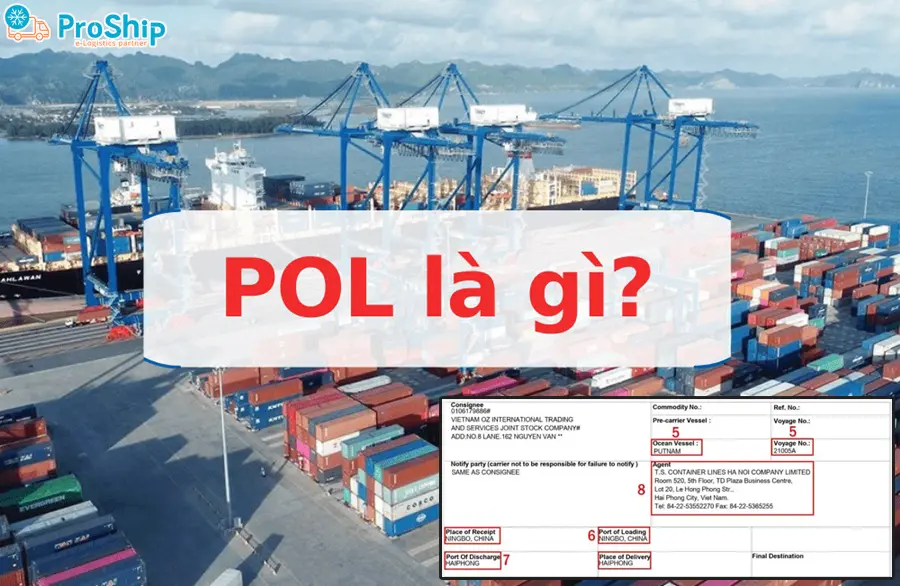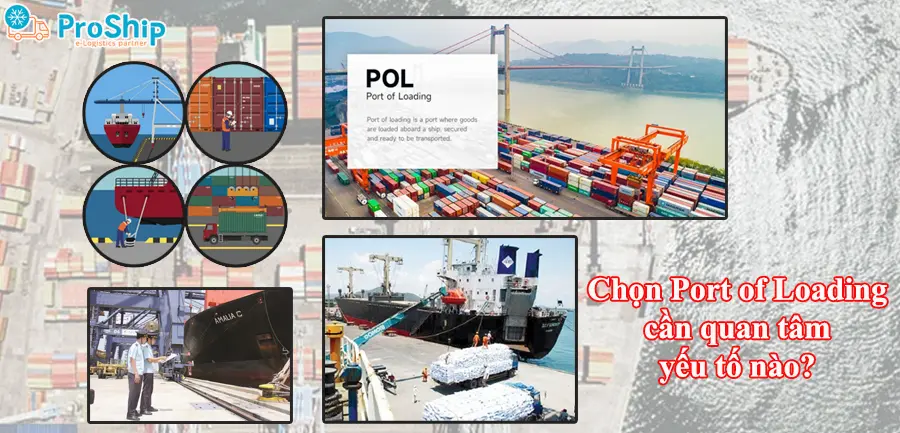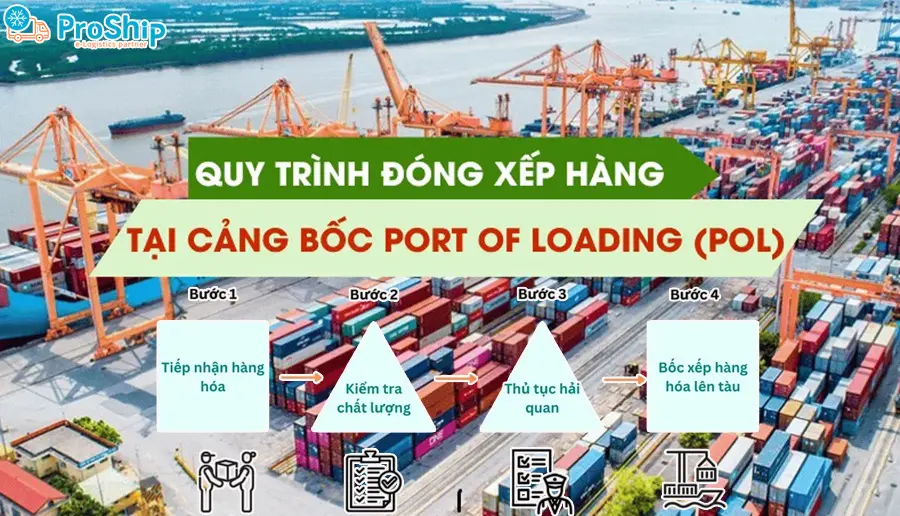x Các tư nhân, doanh nghiệp có lô hàng vận chuyển đường biển, cần biết các thuật ngữ về cảng biển như Port of Loading là gì?
x Bạn chưa hiểu hết vai trò của cảng Port of Loading là để làm gì? Lựa chọn Port of Loading cần cân nhắc tới các yếu tố nào?
x Và bạn muốn tìm hiểu kỹ hơn về cách thức, quy trình đóng xếp hàng hóa tại Port of Loading được diễn ra như thế nào?
Proship.vn chúng tôi sẽ tổng hợp kiến thức liên quan giúp bạn hiểu được port of loading là gì trong xuất nhập khẩu, port of loading đóng vai trò quan trọng ra sao trong chuỗi cung ứng logistics. Và qua đây các chủ hàng cũng biết các yếu tố cần quan tâm khi chọn POL cũng như quá trình đóng xếp hàng tại cảng POL diễn ra như thế nào.
XEM THÊM: Nhận vận chuyển Container giá tốt
Port of Loading là gì? Có vai trò gì?
Port of loading là gì?
Port of loading là gì? Port of loading được hiểu là cảng nơi hàng hóa được chuyển lên tàu để xuất tới điểm đến. Port of loading còn gọi là Port of Exit, cảng xuất phát hay cảng nạp hàng. Port of loading là một trong những thuật ngữ quan trọng trong lĩnh vực logistics và thương mại quốc tế.

Vai trò Port of Loading trong chuỗi cung ứng
Vai trò của port of loading là gì? Port of Loading (POL) đóng vai trò quan trọng trong hoạt động xuất nhập khẩu và logistics trên toàn thế giới. Xác định đúng POL giúp doanh nghiệp tối ưu hóa quá trình vận chuyển và tiết kiệm chi phí. Cụ thể:
- Quyết định chi phí vận chuyển:
POL ở vị trí thuận lợi sẽ tối ưu hóa, giảm bớt quãng đường vận chuyển, rút ngắn thời gian vận chuyển, tiết kiệm chi phí. Các cảng Port of Loading lớn có cơ sở hạ tầng, thiết bị bốc xếp tối ưu sẽ giảm thiểu thời gian lưu kho, giảm chi phí xử lý, lưu trữ hàng hóa tại POL.
- Giảm thiểu rủi ro:
Việc chọn POL có hạ tầng, dịch vụ bốc xếp hiện đại sẽ rút ngắn thời gian giao hàng, giúp giảm thiểu rủi ro trong quá trình vận chuyển, bảo đảm an toàn cho hàng hóa từ khi xuất bến đến khi đến nơi. Điều này cho thấy vai trò quan trọng của POL trong việc thúc đẩy hoạt động xuất khẩu và là yếu tố quyết định đến hiệu quả của chuỗi cung ứng toàn cầu.
- Xác định điểm khởi hành:
POL là nơi hàng hóa được đưa lên tàu để bắt đầu quá trình vận chuyển, lựa chọn POL phù hợp giúp định hướng tuyến đường đi tối ưu, đảm bảo quy trình vận chuyển diễn ra thuận lợi và nhanh chóng.
* Tóm lại, việc lựa chọn Port of Loading không chỉ ảnh hưởng đến thời gian và chi phí mà còn quyết định đến sự an toàn và chất lượng của hàng hóa trong quá trình vận chuyển Logistics.
Chọn Port of Loading cần quan tâm yếu tố nào?
Yếu tố cần quan tâm khi chọn port of loading là gì? Proship xin liệt kê các yếu tố sau:
Các dịch vụ vận tải
Các dịch vụ vận tải được cung cấp tại Port of Loading cũng là một yếu tố quan trọng cần xem xét. Các dịch vụ này bao gồm việc tải và dỡ hàng, lưu kho, đóng gói, xếp dỡ hàng hóa trên tàu…Một Port of Loading cung cấp các dịch vụ vận tải tốt giúp giảm thiểu thời gian vận chuyển và đảm bảo an toàn và bảo vệ hàng hóa.
Vị trí địa lý
Vị trí địa lý của Port of Loading là một yếu tố quan trọng cần xem xét khi chọn Port of Loading. Nó ảnh hưởng đến thời gian vận chuyển và chi phí vận chuyển của hàng hóa. Một cảng cách xa nơi sản xuất hoặc nơi tiêu thụ hàng hóa sẽ tăng thời gian và chi phí vận chuyển. Vì vậy, cần chọn một Port of Loading có vị trí địa lý thuận lợi để giảm thiểu thời gian và chi phí vận chuyển.
Yêu cầu pháp lý của cảng
Một số cảng có các quy định khắt khe về an toàn và bảo vệ môi trường, cần tuân thủ các quy định này để tránh bị phạt hoặc bị tịch thu hàng hóa. Ngoài ra, cũng cần xem xét các quy định hải quan và thuế nhập khẩu của đất nước đó để đảm bảo tuân thủ đầy đủ các quy định pháp lý.

Các yêu cầu thời gian
Nếu bạn cần giao hàng hàng hóa trong một khoảng thời gian nhất định, cần chọn một cảng có thời gian xếp dỡ hàng hóa và thời gian vận chuyển phù hợp với yêu cầu của bạn.
Các loại hàng hóa
Một số Port of Loading đặc biệt phù hợp với các loại hàng cụ thể. Ví dụ, một số cảng chỉ chuyên vận chuyển hàng lỏng như dầu, gas hoặc hóa chất, trong khi đó, một số cảng khác phù hợp hơn với hàng rắn như than, gỗ, xi măng. Vì vậy, khi chọn Port of Loading, cần xem xét loại hàng hóa mà bạn đang vận chuyển và chọn một cảng phù hợp với loại hàng hóa đó.
NÊN ĐỌC: Hỗ trợ vận chuyển Container lạnh giá tốt
Quy trình đóng xếp hàng hóa tại cảng bốc POL trong logistics
Quy trình đóng hàng tại cảng POL không quá phức tạp nhưng bạn cần tìm hiểu rõ các bước để đảm bảo tuân thủ chính xác, tránh sai sót và mất thời gian:
Bước 1: Xin booking và lệnh cấp container rỗng
Doanh nghiệp cần xin booking và lệnh cấp container rỗng từ hãng tàu. Một số hãng tàu cho phép gửi qua email, nhưng có hãng yêu cầu đến trực tiếp văn phòng để lấy lệnh.
Bước 2: Đóng phí trải bãi
Sau khi nhận được lệnh cấp container và booking, doanh nghiệp liên hệ với cảng để đóng phí trải bãi, tùy thuộc vào phương thức đóng hàng.
Bước 3: Đăng ký ngày lấy container rỗng
Bạn cần đăng ký lấy container rỗng với bộ phận điều độ, nên thực hiện việc này trước một ngày để tránh tình trạng thiếu container hoặc gặp phải container kém chất lượng.
Bước 4: Nhận và kiểm tra container
Sau khi nhận container, cần kiểm tra kỹ tình trạng container (nóc, sàn, góc cạnh) và chụp hình lại trước khi đóng hàng. Nếu container có vấn đề, hãy yêu cầu đổi ngay để đảm bảo an toàn cho hàng hóa trong quá trình vận chuyển.

Bước 5: Đóng hàng tại cảng
Sau khi kiểm tra container, liên hệ với điều độ cảng để sắp xếp công nhân và thiết bị cần thiết (xe nâng, cẩu) cho việc đóng hàng. Đảm bảo hàng hóa được xếp gọn và phân bổ đều trọng lượng để tránh mất cân bằng khi vận chuyển, kiểm tra kỹ số lượng hàng hóa và ghi lại tình trạng để tránh trách nhiệm nếu có vấn đề phát sinh. Giám sát chặt chẽ để tránh mất mát hoặc trộm cắp hàng hóa trong quá trình đóng hàng.
Bước 6: Nộp packing list và VMG để thông báo điều độ cảng
Sau khi hoàn tất việc đóng hàng, bạn cần gửi packing list và VMG cho bộ phận điều độ cảng để tiến hành nhập thông tin vào hệ thống quản lý của cảng.
Bước 7: Hoàn tất thanh lý và vào sổ tàu
Cảng sẽ thực hiện thanh lý, ghi nhận lô hàng vào sổ tàu. Quá trình đóng xếp hàng tại cảng chính thức hoàn thành sau khi các thủ tục này được hoàn tất.
Proship Logistics với kinh nghiệm nhiều năm trong lĩnh vực vận chuyển container đường biển Nội địa và Quốc tế đã chuyển tải kiến thức cần biết về port of loading là gì. Có thể nói, Port of Loading đóng vai trò quan trọng trong quá trình vận chuyển quốc tế, là điểm khởi đầu cho hành trình xuất khẩu hàng hóa. Quý doanh nghiệp quan tâm và cần tìm hiểu về cảng xếp hàng POL nên tham khảo và liên hệ ngay 0909 344 247 để được tư vấn các loại hình vận chuyển hàng FCL/LCL từ Cảng – Cảng, Cảng – Kho, Kho – Kho giá rẻ tốt nhất.

